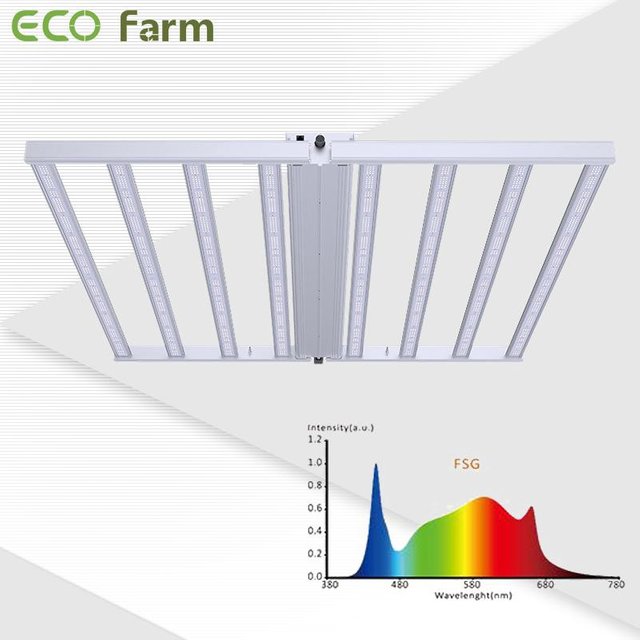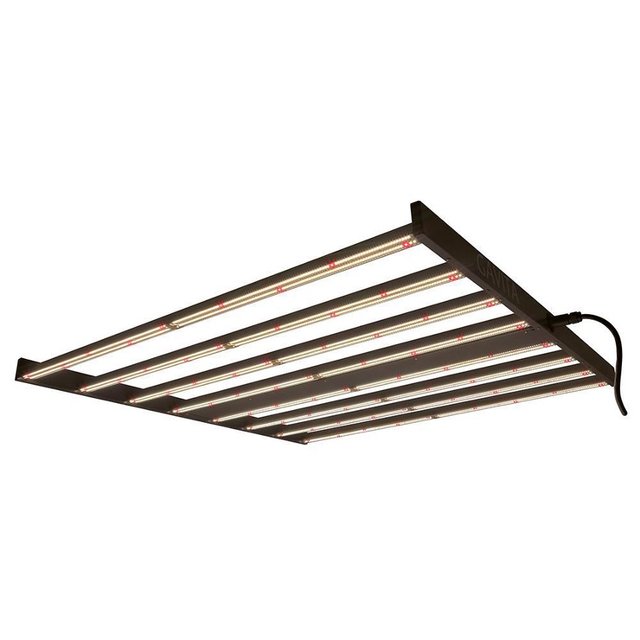One of the most popular light types to use when growing plants indoors is a full spectrum LED grow light. These lights feature all the needed colors (such as blue and red) that plants need in order to survive when grown indoors. Besides these though, full-spectrum lights also include IR and UV bulbs which help with the blooming and flowering stages of your plants. This article will highlight and compare two of the top LED full spectrum grow lights that should be using in your growing space.
Is the Light Spectrum Important For Your Plants Growth?
Of course, while getting the necessary light output is very important for your plants, the spectrum of light they receive is also important. Outdoor plants evolved to grow under natural sunlight, which produces every color on the spectrum. Therefore, the best grow lights have a full-spectrum grow light to best mimic natural sunlight and optimize plant growth.
Within the full spectrum, each wavelength (color) is responsible for a different effect on the plant’s growth. Blue and red light are the most prominent colors since blue drives stockiness in a plant during its vegetative stage, while red light helps plants stretch and bloom in the flowering stage. However, plants also utilize other colors. Greenlight is not as easily absorbed by the plant for photosynthesis, so that makes it more effective at penetrating the plant canopy and delivering light to areas that are less saturated with light. Therefore it is optimal to use a full-spectrum light that uses a combination of all colors at all stages of growth.
Does Plant Grow Faster Under Led Lighting Than Regular Light?
Why natural light and grow lights both have their advantages, ultimately, grow lights better for the indoor growing environment.
This is mainly because you have a high level of control over the artificial habitat.
The intensity of the light can be manipulated, and so can the humidity and temperature.
The indoor grower also has the ability to provide supplemental carbon outside, which is ineffective outdoors.
The controlled indoor environment is also free from pests and the risk of outside elements.
These outside elements, such as weather, pets, and so on, can greatly affect growth and harvest and are some of the disadvantages of outdoor plants growing.
With grow lights, light intensity and duration are always constant and consistent throughout the entire growing period.
Therefore, it can be said that grow light is better for your plants than natural light.
ECO Farm MG8 660W Foldable LED Grow Light with OSRAM Chips
Features:
The ECO Farm LED grow light operates at 660 watts with an output of 1848 µmol s-1 PAR and an impressive efficacy of 2.8 µmol s-1 per watt. The Pro 1700e delivers broad, intense light coverage with its 8 passively cooled LED bars that allow you to place it closer to your canopy than other lights, cut down cooling costs, and maintain a perfect growing environment. Until now, cutting energy costs and delivering maximum light output have been opposing priorities for growers. This fixture solves that. This LED is powerful enough to deliver the same high-performance growers rely on while reducing energy and lifetime ownership costs. Everyone wants to look for ones with high efficacies, so you can get the highest light output for each watt of electricity you are paying the power company for. Our ECO Farm Led grow lights have a very high efficacy of 2.8, which is among the best in the industry.
Nominal Wattage: 660W-8bar
Spectrum: Full Spectrum FSG(4000K)
PPF: 1848μmol/s
Efficacy: 2.8 μmol/J
Mounting Height: ≥6” (15.2cm) Above Canopy
Thermal Management: Passive
Dimming: 0–10V / 1–10V
Light Distribution: 120°
Lifetime: >54,000 hrs
Dimming: 0–10V dimming,
with dimming knob
Power Factor: >90%
Cords & Interfaces: Comes with 3m power cord with US plug, and 2pcs RJ14 interfaces.
Certifications: IP65, ETL, CE
Dimension: 43*42.7*2.8 inch
Weight: 21.6 lbs / 9.8kg
Warranty: 3 Years Standard Warranty
Gavita Pro 1700e Gen2 LED Grow Light
Features:
This Gavita LED has a lower wattage than you may think with just a 645-watt power draw. It can replace a 1000 Watt HPS without sacrificing any light or quality. And boasting an incredible 2.6 umol/J and a light output of 1700 umol/s the Pro 1700 LED provides high-intensity full spectrum light over its entire 4'x4' to 5'x5' flowering footprint. The wide 8-bar form factor helps to provide even coverage across your canopy. This powerful, full-spectrum light source is intended for full-term plant growth from the vegetative stage to the higher-light-requiring bloom and finishing stages. Built with premium Philips drivers, Samsung white LEDs, and Osram deep-red LEDs, this fixture uses only the highest-quality components. This fixture is passively cooled so that it produces almost no heat. Don’t worry it will hurt your plant.
Wattage Draw: 645 watts (120V)
HPS equivalent: 1000 watts
Diodes: 3,336; Samsung and Osram
Spectrum: Full-spectrum white with enhanced red for seed to flower growth
PPF (light output): 1700 umol/s
PAR Efficacy: 2.6 umol/J
Coverage area:
Flowering footprint: 4'x4' to 5'x5' (16 to 25 sq ft)
Vegetative footprint: 6'x6' to 7'x7' (36 to 49 sq ft)
What Makes A Good LED Grow Light?
Here are some important things that you should look for in a good LED grow light:
1. Full spectrum ( including IR and UV )
A full spectrum LED grow light will give your plant every wavelength of light it requires to maximize its growth ( bigger yields ).
Most manufacturers will provide details or charts about their light's spectral output. Look for blue lights between 430nm-450nm for the vegetation stage and red lights between 640nm-680nm for the flowering stage.
You should also look for an LED grow light that includes UV ( ultraviolet ) and IR ( Infrared ) diodes.
Ultraviolet light has been shown to make your plants react defensively and produce more trichomes. This leads to an increase in THC levels ( higher potency )
The benefits of Infrared are a little more debated, but many experts believe that it promotes larger leaf growth and increases yield size.
2. High PAR output
PAR ( measured in umol/2/s ) is the spectrum of light that your plants use for photosynthesis, so you want to feed them a lot of it.
Most good manufacturers will provide you with a chart showing you how much PAR your plants will get at various heights.
Between 200–400 umols is perfect for seedlings. Between 400–600 umols is perfect for late vegging cycles, and 700–900 umols is the perfect amount for flowering.
3. Daisy Chaining Functionality
A very useful feature if you need to buy multiple lights.
This functionality allows you to plug one light into another light so that you only need one power chord.
This makes it easier to hang your lights side-by-side, keeps your grow space organized, and frees up socket space.
4. Veg & Bloom Switches
Veg & Bloom switches allow you to optimize the intensity of your lights for the different stages of your grow cycle.
This prevents your young plants from getting light burn and saves you money on your electricity bill.
5. Good Warranty
Make sure you pick a grow light with a warranty of 2–3 years.
LEDs should last for more than 10 years, but having a decent warranty will give you peace of mind that if anything goes wrong, you will get a replacement or refund
6. Responsive Customer Service
This is vital. If something goes wrong with you’re light, you want to have purchased from a company that will get back to you quickly and makes things right.
7. High Actual Wattage
Many manufactures name their grow lights after the total wattage of LED chips inside the light.
For example, a grow light with 120 5w LED chips might be advertised as a 600w grow light. The actual power is the wattage that it draws from the socket. Keep an eye out for text like “consuming only 160 watts!” — this is the light's actual wattage as opposed to the LED chips.
Conclusion
LED grow lights are a must-have item for every indoor gardener, no matter what you’re growing. From house plants to vegetables, LED grow lights can help give your plants the light that they need without having to worry about cracking open the blinds.
The main 3 types of grow lights are LED, HID (HPS/MH), and Fluorescent. Each type of grow light has its pros and cons, but when all is said and done, we believe LEDs are the best overall investment for producing high-quality crops for the best cost.
Picking the right LED grow light to suit your plant’s needs may seem like a daunting task, but the good news is that most qualities LED grow lights will come with an array of settings to give each of your plants the amount of light that they require. A top pick, the ECO Farm LED Plant Grow Light is a great example of what a top-of-the-line grow light with several settings can do.


We should make our houses as eco as possible.
Downvoting a post can decrease pending rewards and make it less visible. Common reasons:
Submit